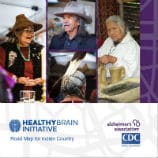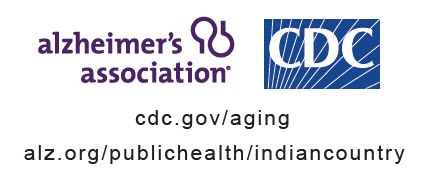Indian Country Public Health Programs

Available for Download [PDF – 564 KB]
Several public health efforts are aimed at improving the health and well-being of American Indian/Alaska Native (AI/AN) communities. These programs and resources help address chronic conditions and improve the public health response throughout Indian Country. AI/AN leaders can use these efforts to incorporate into their broad response to Alzheimer’s and other dementias.
The Special Diabetes Program for Indians (SDPI) aims to diagnose, control, and prevent diabetes. Established in 1997, this $150 million annual grant program provides funds for diabetes treatment and prevention to Indian health programs across the country. It is coordinated by the Indian Health Service (IHS) Division of Diabetes with guidance from the Tribal Leaders Diabetes Committee.
Culturally-tailored smoking cessation programs show promise in increasing smoking abstinence. All Nations Breath of Life (ANBL) for American Indians is one such program. It has been successful in recruiting, engaging, and retaining American Indian smokers in a randomized controlled trial of smoking cessation.
CDC’s largest investment to improve health among AI/ANs is the Good Health and Wellness in Indian Country (GHWIC) program. This $78 million initiative supports prevention activities for heart disease, stroke, diabetes, smoking, nutrition, physical activity, and obesity. The program’s prevention activities have expanded to reach over 130 tribes and urban clinics. Federal funds are also used to support 12 Tribal Epidemiology Centers (TECs) across the U.S. and one Network Coordinating Center. Their mission is to improve delivery of public health functions to tribes and villages in their regions.
The Centers for Disease Control and Prevention (CDC) and the Alzheimer’s Association have created the Healthy Brain Initiative’s (HBI) Road Map for Indian Country.
It is designed to help American Indian and Alaska Native (AI/AN) community leaders learn about dementia and start discussions throughout their communities. The Road Map for Indian Country suggests eight public health strategies that embrace community strengths including traditional practices, resilience, and existing services.

Tribal Practices for Wellness in Indian Country is a three-year, $15 million program launched by CDC in 2018. Its goal is to strengthen cultural practices and traditions that build resilience and connections to community, family, and culture. Over time, these can reduce risk factors for dementia and many other chronic diseases. The program funds 21 tribes and 14 urban Indian organizations.
To emphasize the connection between heart health and brain health, the Association of State and Territorial Health Officials (ASTHO) and the International Association of Indigenous Aging (IA2), with support from CDC, jointly produced a series of HBI communication materials tailored for Indian Country. These products include radio PSAs, news articles, posters, and fliers intended for community-wide distribution as well as videos that can be shown in clinic settings, and a guide for healthcare providers with culturally-appropriate messaging.

Disclaimer: The mark “CDC” is owned by the U.S. Department of Health and Human Services (HHS) and is used with permission. Use of this logo is not an endorsement by HHS or the Centers for Disease Control and Prevention (CDC) or any particular product, service, or enterprise.